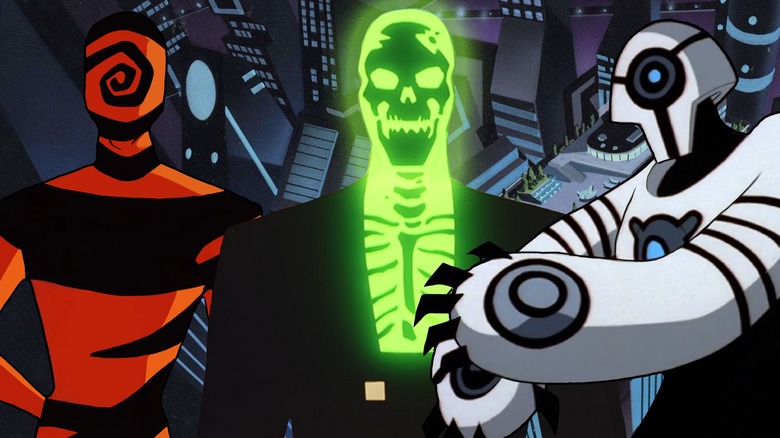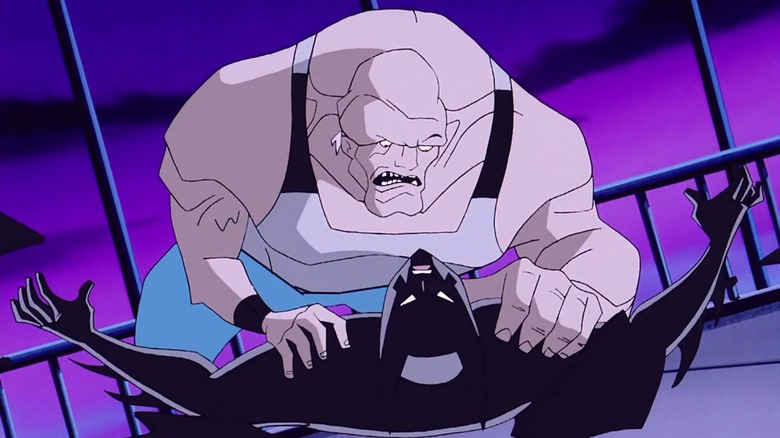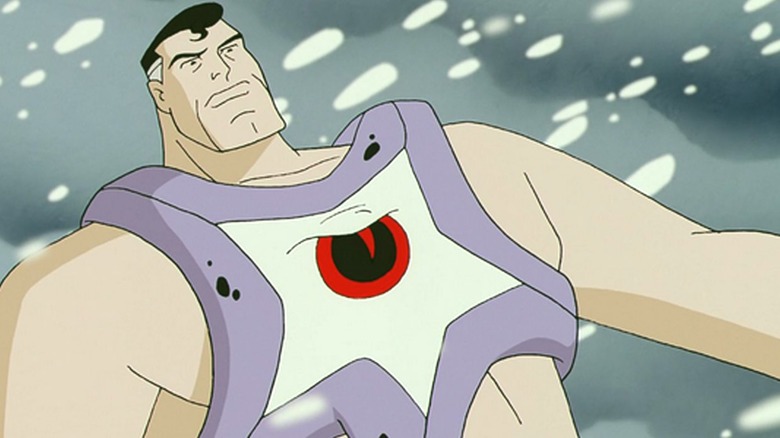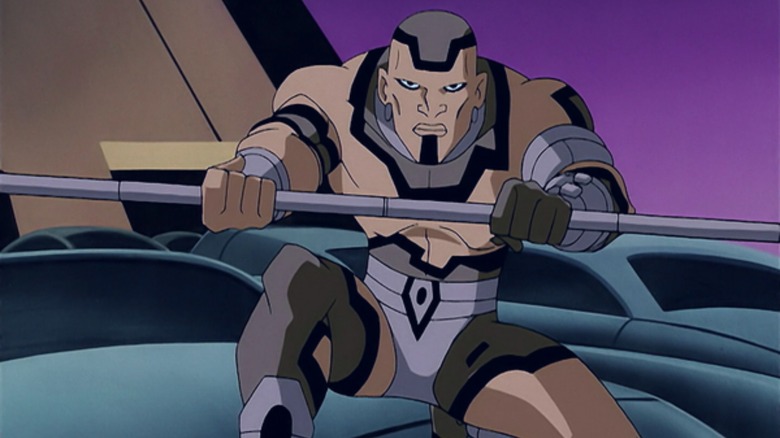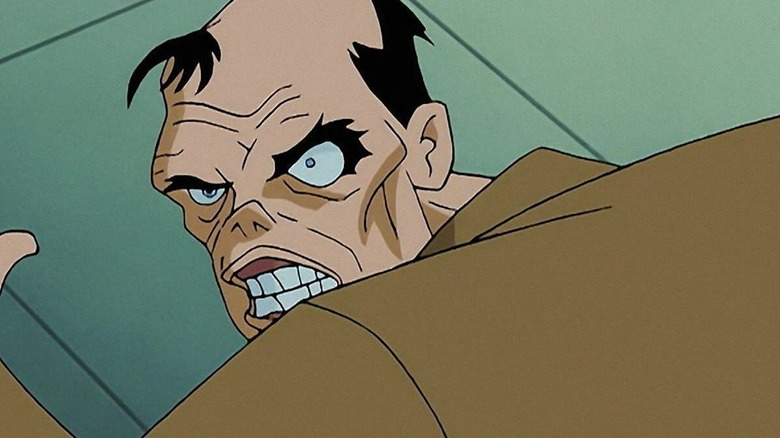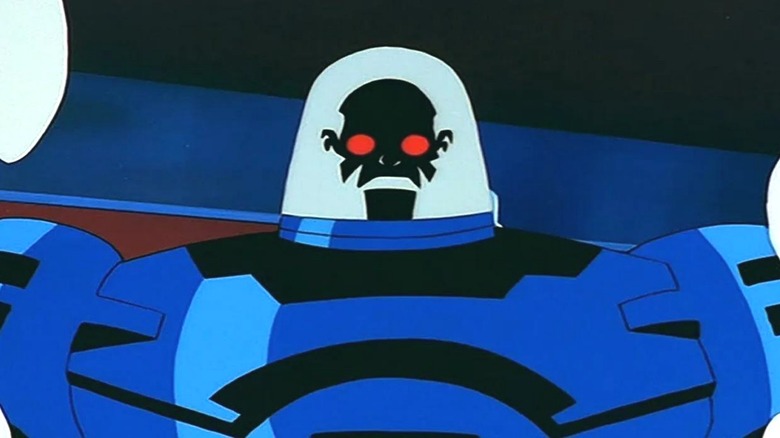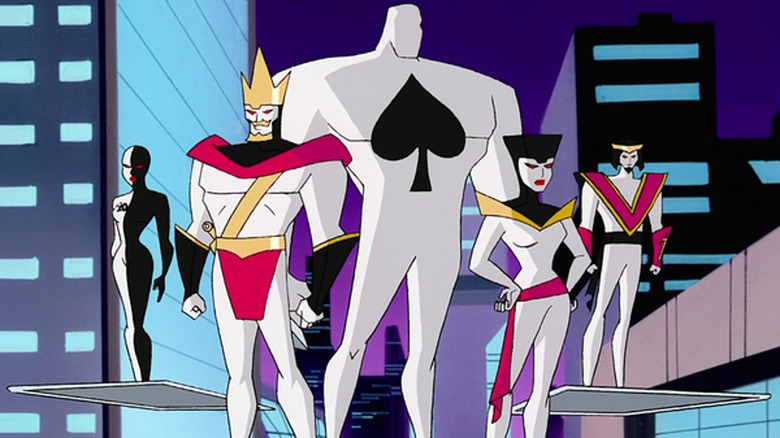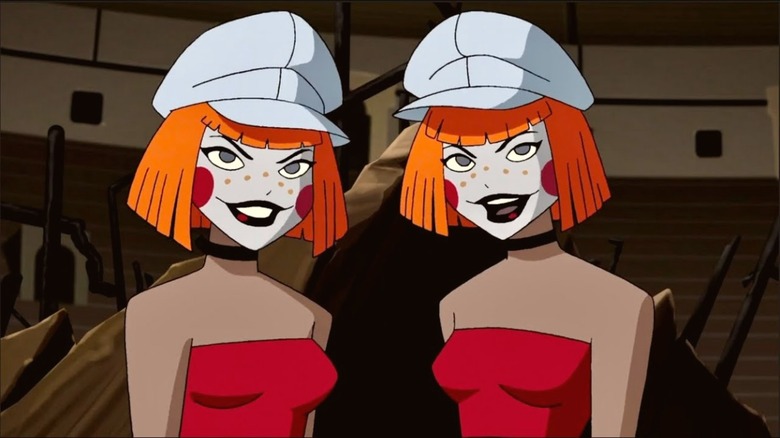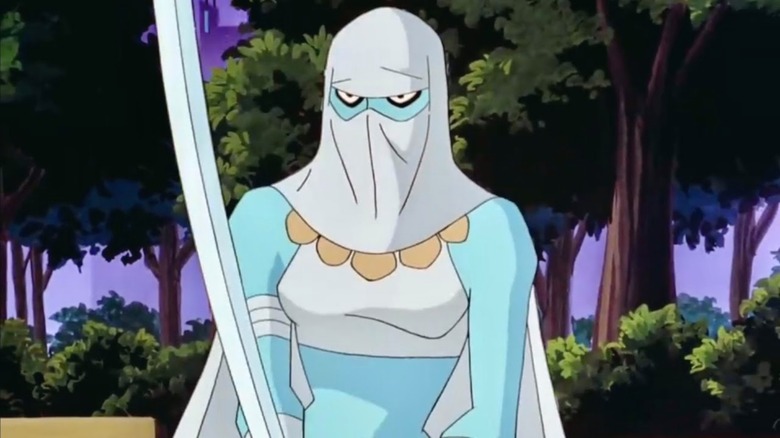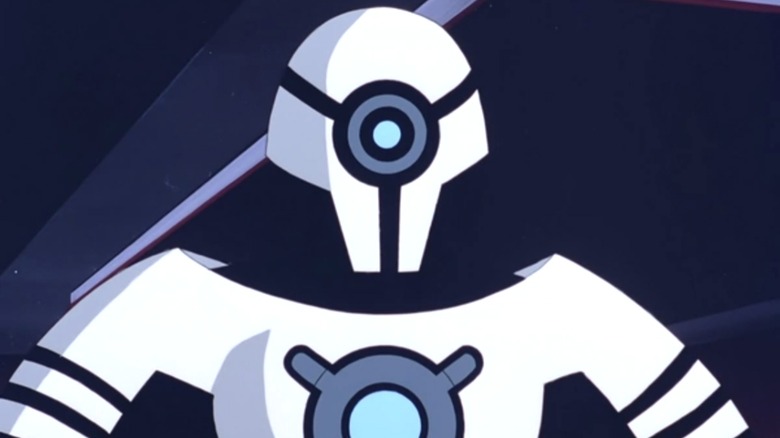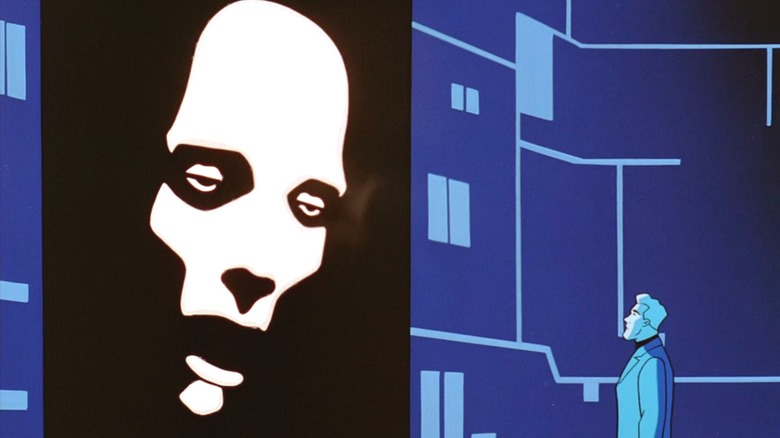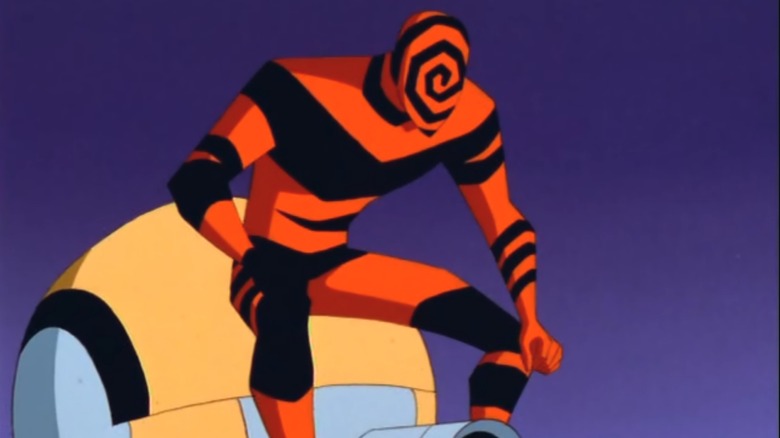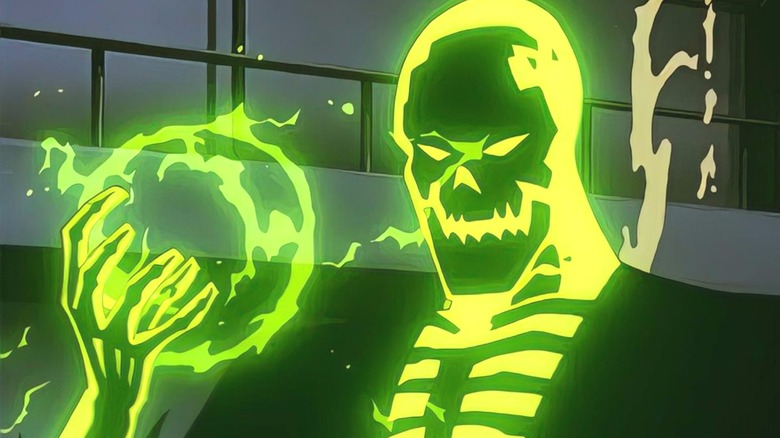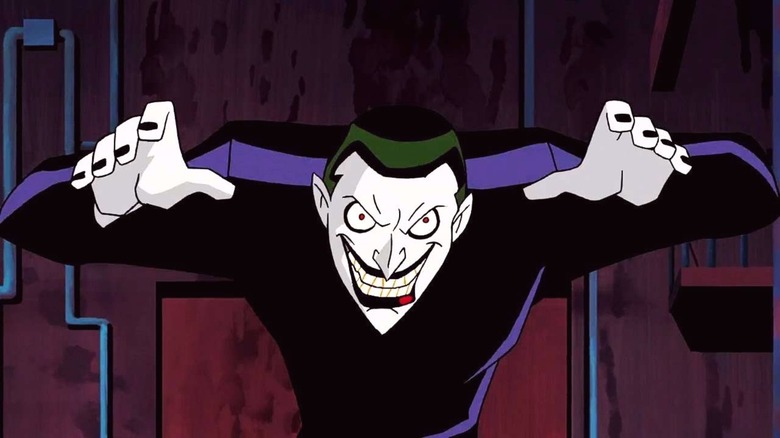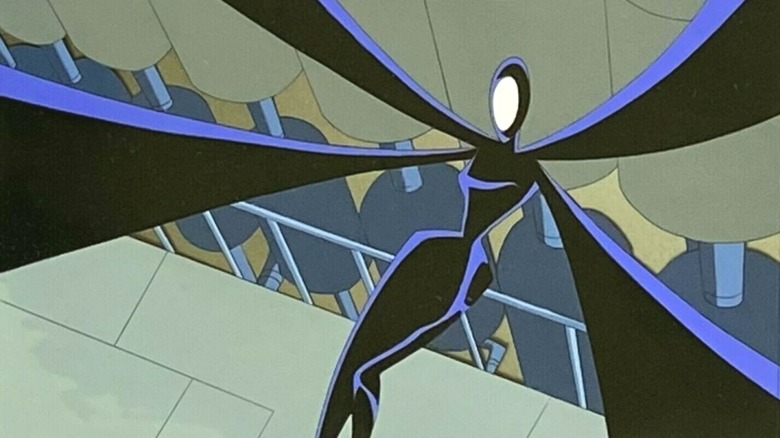The Best Batman Beyond Villains, Ranked
Batman has been around for a long time, first appearing in "Detective Comics" #27 in 1939. He's built up a massive rogues gallery since then, filled with some of comics' greatest villains. For 60 years, Batman stories revolved around Bruce Wayne. He always led the line, taking the fight to the bad guys with the help of his Bat-Family in order to protect Gotham City, but that all changed in 1999. That's the year "Batman Beyond" hit TV screens, and it did something unheard of until then: it replaced Wayne as Batman.
In stepped Terry McGinnis, a teenager in the year 2039, becoming the Batman for a new generation. He protects Neo-Gotham with Wayne working as his guy in the chair, guiding him from afar and offering sage advice. "Batman Beyond" served as a sequel series to "Batman: The Animated Series" and "The New Batman Adventures." It's a bolder, darker show than its predecessors, and its villains (including some legacy bad guys) very much reflect that. The following villains are the best that the classic series has to offer.
14. Big Time
Charlie "Big Time" Bigelow was Terry's best friend going back to his time as a petty criminal. While Terry went on to become the new Batman, Charlie repeatedly chose a life of crime. During a robbery, he's exposed to a mutagenic compound called Cerestone, transforming him into a supervillain. He embraces his nickname and becomes the superpowered bad guy known as Big Time.
Big Time tries to rope Terry into his criminal scheme, but the latter refuses, causing a rift to form between them. This leads Big Time to try and kill Terry, but Bruce Wayne stops him in the nick of time, leaving Terry a moment to don his cape and cowl to fight his former friend. Ultimately, Big Time falls from a bridge and is believed to have died.
Big Time is an excellent villain for the new Batman because he's much like Harvey Dent was to Bruce Wayne. Bruce failed to save him from becoming Two-Face, and Big Time represents a similar failure for Terry. One of the people he once trusted the most became someone determined to kill him, making Big Time one of Bats' saddest villains.
13. Starro
Starro is an iconic DC villain in that he's the first to do battle with the Justice League, having gone up against the team in its debut appearance in 1960's "The Brave and the Bold" #28. He's also one of the strangest — this starfish-like alien comes from a water planet and is able to control minds. In "Batman Beyond," Superman takes Starro to his Fortress of Solitude and he remains there for decades. In a surprise attack, Starro leaps onto Superman and gains control of the Kryptonian, making him incredibly powerful — and he has a plan.
Starro spends years making clones while hiding under Superman's costume, and, like always, he intends to take over the world. Starro-controlled Superman enlists Batman in a scheme to find and kill members of the Justice League Unlimited, but he's exposed and flees to the Fortress, where the JLU confronts him. Batman breaks Starro's psychic hold on Superman, freeing him.
The best part of seeing Starro in "Batman Beyond" is the closure regarding the supervillain starfish. He's ultimately sent to his home planet, where he cannot harm anyone on Earth, peacefully ending a villain's story after 40 years of appearing in the comics. Starro's cunning nature makes him a fantastic foe, but in the end, he is just a displaced psychic starfish who never wanted to leave home in the first place.
12. The Stalker
Stalker was a big game hunter who was badly injured while going after a panther. His broken back got repaired, and the surgery turned out to be a massive success: He attained superhuman strength and reflexes, but his new abilities made hunting too easy. Without a challenge from traditional targets, Stalker decides to hunt the most dangerous game there is: Batman.
He fights Batman and learns his secret identity, using Terry's brother as bait, but Batman gets the upper hand. Batman believes Stalker is dead, but he returns and is forced to work for the NSA. In this capacity, he and Batman have an unlikely team-up to locate Falseface. They track down their quarry, and Stalker even saves Batman, which he admits he does only to ensure they have their ultimate showdown fight.
Stalker is more than a DC version of Marvel's Kraven the Hunter, though the truth is there are some obvious similarities. Working with his nemesis to ensure he has a final fight with him is an interesting twist for the character, and while that fight never made it to the airwaves, had the show continued beyond its third season, it would have been something to see.
11. Falseface
There's not much known about Falseface's past, though a different character used the same moniker in Bruce Wayne's day as the Dark Knight. Falseface possesses the ability to completely alter his face in size, shape, and color, though it's unclear how he does this. His ability makes it easy for Falseface to get in and out of places by pretending to be someone else, and he successfully fools Batman in one meeting.
Falseface is hired to move a virus into Gotham City, and is ultimately infected. He then adopts the visage of Nelson Nash, making him stand out to Batman. They end up fighting, and Falseface's real face is revealed. He comes close to killing Batman, but the virus kicks in just as he's about to take out his foe. Falseface doesn't get far before collapsing, though his ultimate fate remains a mystery.
Any criminal who can disguise themselves as anyone they want has an edge. Marvel Comics has Chameleon, but in DC, Falseface is better, as he can naturally disguise himself without the need for prosthesis, makeup, or other means. He's an intriguing villain who could have been more interesting had he appeared in more than a single episode: He only popped up in "Plague" in "Batman Beyond," but he certainly makes an impact.
10. Mr. Freeze
Mr. Freeze is a historic Batman villain who broke the law many times in an effort to save his wife, Nora. He's an interesting supervillain in that he knows what he does is wrong, but he unapologetically violates the law because he wants to save his wife. The accident that transformed him also rendered him immortal, though only his head survived into the 21st century.
He spent decades in a storage facility before scientists transplanted his brain into a cloned body, returning him to normal. Initially, the process worked, and he started his life anew, but it didn't last. His cloned body reverted to his previous state, requiring an advanced cryogenic suit to sustain him. He goes after the scientists who betrayed him and fights Batman. In "Batman Beyond," Freeze actually saves Batman in his final act, allowing himself to be destroyed in the process.
Mr. Freeze is one of Batman's most tragic villains, and this is clear in his attempt to redeem his past actions with good deeds. "Batman Beyond" offers a beautiful epilogue to the remorseful supervillain who plagued Gotham City for so long. It's a sad but honorable end for a man who was arguably more victim than villain.
9. The Royal Flush Gang
The Royal Flush Gang is a group consisting of five members: King, Queen, Jack, Ten, and Ace. There have been a few different iterations over the decades, but the one that features in "Batman Beyond" is a family of thieves. Each member has their own bag of tricks. King is a swordsman, Queen is a melee weapons expert, Jack is all about knives, Ten is a hacker, and Ace is an android.
The group appeared in a few episodes of "Batman Beyond" and in other series, including "Justice League" and "Justice League Unlimited." They initially surface upon learning that a new Batman is working in Gotham and set their sights on vengeance. Happenstance leads to Terry dating Melanie Walker, who is actually Ten, and things devolve from there.
Ten is much like Catwoman was to Bruce Wayne in his earlier years, as Terry cares for Melanie greatly. Eventually, she reforms and gets a day job, but her time with Terry during her criminal days aids in his character development significantly. The gang doesn't work quite as well when one member is captured or taken down, or they'd be ranked higher. Together, they represent a huge threat to Batman.
8. The Dee Dee Twins
After the Joker dies, Harleen Quinzel hangs up her harlequin suit and gives up her life of crime. By the time Terry becomes the new Batman, her grandchildren, Delia and Deirdre Dennis, are all grown up and calling themselves the Dee Dee twins. Harley tries to raise them to be good, but the twins follow in her footsteps, becoming fascinated with the Joker.
Delia and Deirdre join a criminal organization called the Jokerz and pick up where their grandmother left off decades earlier. The first time they face Batman, he takes them for little more than young girls out of their element. They school him pretty quickly, working together to take him down. He's not so overconfident in their next engagement, but, eventually, they're caught.
The Dee Dee twins are especially interesting because of their connection to Harley Quinn's dark history, particularly when it comes to Quinn's toxic relationship with the Joker. They are also incredibly skilled hand-to-hand combatants, and by working together, they pose a legitimate threat to Batman. The Dee Dee twins only appeared in the series' direct-to-video movie "Batman Beyond: Return of the Joker" (not counting their cameo in "Justice League Unlimited"), but they still managed to make a big impression.
7. Curaré
Curaré is the best assassin in the Society of Assassins. Nobody knows her name, nor have they seen her face — other than Batman, that is. She's the deadliest woman alive and is expertly skilled in martial arts. Her weapon of choice is a scimitar with an edge so thin that it can cut through anything, up to and including incoming bullets.
Curaré sets out to kill Gotham's District Attorney, but Batman and Barbara Gordon manage to stop and capture her. She escapes, but knowing that the Society of Assassins' answer for failure is death, she's not safe. Curaré hunts down every member of the organization and erases their minds, stopping them from taking her out. In the end, she destroys the society from the inside, making her the deadliest assassin in the world.
Bruce Wayne has dealt with his fair share of assassins over the years, but none match the lethality of Curaré. That makes her an excellent villain for Terry and also sets her apart from everyone who came before her, arguably even Ra's al Ghul, who trained her. With a range of abilities and a cool design, Curaré is undoubtedly one of the greatest villains in "Batman Beyond," despite appearing in only two episodes.
6. Shriek
A common trope in comics is taking a person's talent and magnifying it into a superhuman ability. This applies to Walter Shreeve, a sound engineer who uses his skills to create a suit capable of controlling generated sound waves. After donning his suit, he appropriately calls himself Shriek and sets out on a life of crime, bringing him to Batman's attention.
His first evil act is to try and assassinate Bruce Wayne. He fails to do so, and it costs him his hearing. Despite this, he doesn't give up and uses his unique abilities to render all speech unintelligible throughout Gotham. In his third and final episode appearance, Shriek traps Batman in an underground complex, hoping to kill him. Some monologuing costs him his prize, and Bruce Wayne stops him, ending his crime spree in "Batman Beyond."
Shriek is an interesting villain because he doesn't want to be a bad guy. He's shoehorned into doing bad things and ultimately becomes a villain after his initial failure. That's not to say that attempting to kill Bruce Wayne wasn't villainous, but initially, it was merely a means to an end — his return is what makes him a compelling supervillain.
5. Robert Vance
Robert Vance was a successful computer programmer and founder of a software company during Bruce Wayne's time as Batman. Before he could die from an incurable brain disorder, he digitized himself and lay dormant for decades. Thirty-five years later, Vance's grandson, Bobby, inadvertently places him online, and he initiates his longstanding plan to integrate his digital consciousness into a new body.
Batman attempts to thwart this plan, so Vance invades his Batsuit and attempts to drown him. Fortunately, Wayne previously installed a killswitch in the suit, so he's able to stop Vance from murdering his protégé. This stumps Vance but doesn't kill him. He finds his way back to his lab and works to transfer his mind into Bobby's body. Eventually, Batman stops him with the power of magnetism, and Vance is purged forever.
What makes Vance such an interesting villain for Terry is his ability to take over his suit. He forces Batman to don an eye mask and fight his own Batsuit in one of the most memorable "Batman Beyond" clashes. He's also fascinating for enacting a decades-long plan to stave off his own demise, making him particularly crafty and insidious. He only appears in one episode, but it's a good one, largely due to Vance.
4. Spellbinder
Being a high school psychologist can be tough work. For Ira Billings, it became a nightmare. Instead of looking for new work, he used his skills to get back at the wealthy people he despised: He used mind control to force students to steal from their parents, becoming the supervillain Spellbinder.
Billings created a suit with a floating eye affixed to his hand, which could project images into his targets' minds. He sets his sights on Terry, hoping to score info on Bruce Wayne. Spellbinder successfully manipulates Batman with visions of zombies and tries to kill him, but the tables turn and Spellbinder is taken into custody. They have several engagements throughout the series, and Spellbinder manipulates numerous people to get what he wants.
Billings is a villain who can break into anyone's mind, including Batman, which makes him incredibly dangerous. He actually tricks Commissioner Barbara Gordon into believing Batman killed Mad Stan at one stage, leading to a manhunt. It all works out for Batman in the end, but Spellbinder puts him through some serious turmoil each time they face one another.
3. Blight
As the corrupt CEO of Wayne-Powers, Derek Powers created a viral nerve gas that wasn't in line with the Wayne half of the business. After being exposed to the gas during a fight with Batman, he was forced to seek radiation treatment, mutating him into a superpowered radioactive being with translucent skin. He initially uses a false skin to appear normal in public, but he eventually embraces his new form and abilities under the name Blight.
Just like Batman did before Powers was transformed into Blight, the hero continues to thwart the villain's plans. In their final showdown, Blight becomes enraged after his son double crosses him, destroying and sinking the submarine they're all on, though Batman believes he somehow survived.
Powers was a villain long before his accident turned him into Blight, which is why he's such a compelling character. Bruce Wayne was no fan of the man and confronted him in the boardroom on several occasions, but in Powers' entanglements with Terry as Batman, the madness beneath the malice really shines through.
2. The Joker
The original Joker was presumed dead for decades but is revealed to be alive and well in "Batman Beyond: Return of the Joker." He leads the Jokerz and reveals himself to Bruce Wayne, letting him know that he knows about Terry. This upends Bruce's worldview, and then the truth about the Joker's fate is revealed: Forty years earlier, Joker and Harley Quinn kidnapped Tim Drake, aka Robin, the Boy Wonder, and tortured him. They also brainwashed him, prepping Tim to become the new Joker.
In a memorable moment, Tim transforms into the Joker, who reveals that he embedded his consciousness into a chip behind Tim's ear. In the ensuing fight, Terry destroys the microchip, killing the Joker persona and returning Tim to normal. It's impossible to deny that the Joker is and always has been Batman's greatest foe. He managed to survive his death to terrorize the Dark Knight decades later by taking over the body of his former ward. The Joker is genuinely evil, and his villainy is on full display in this film.
1. Inque
There's little known about who Inque is or where she came from, but whatever her background, she turned to crime to enrich herself. She became a metahuman through biogenic mutation, gaining the ability to alter her form in a variety of ways. Derek Powers hires her to sabotage a rival company, leading to her first conflict with Batman. Inque makes short work of the hero, but flees the area to get away from him.
The next time they fight, Bats is more prepared, though Inque's overwhelming strength and ability to reshape her body mean she can easily deflect his attacks. Inque quickly becomes Batman's nemesis, and the two fight repeatedly throughout the series, making her his biggest recurring villain. She's cunning and possesses unique abilities that are difficult to counter.
While Terry's Batsuit is impressive, he meets his match in Inque, time and time again. Her background unfolds throughout the series, and her estranged daughter is her motivation to steal more money. This somewhat humanizes the character but also explains why she will stop at nothing to get what she wants. She easily stands as Terry's biggest bad from "Batman Beyond" and is one the most compelling villains in the DC Animated Universe.
